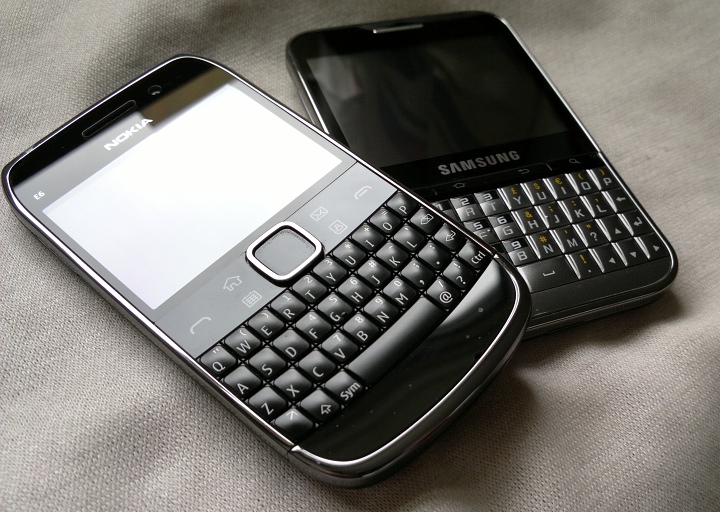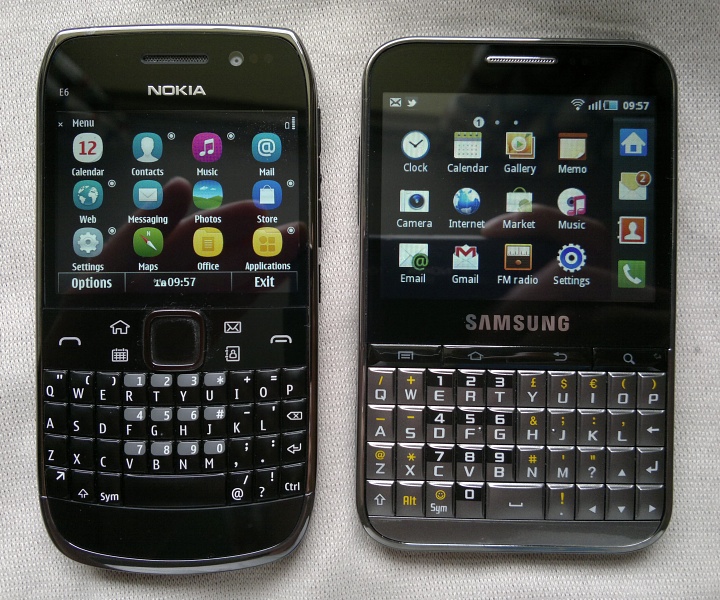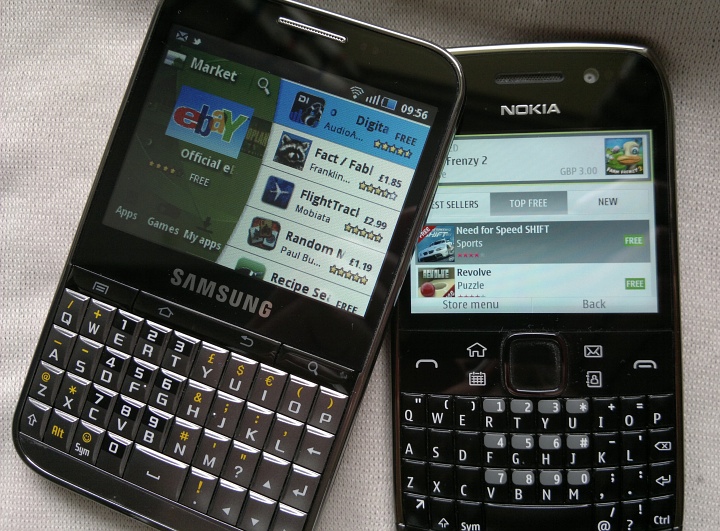
The form factor here, as you can see, is 'qwerty candybar' (or 'slab' or 'front facing qwerty', depending on who you talk to), plus touch. This last bit is what primarily distinguishes the E6 from its predecessors and is, of course, a prerequisite for the Galaxy Pro, since Android is a touch-centric OS.
The price tags, at street values are dramatically different and, as I say, it's unusual for the Symbian device to be the more expensive of the two. But the genre of Android qwerty candybars is a new one and the Galaxy Pro is almost unique (in fact, there's now the new HTC ChaCha on the market as well, adding a 'Facebook' button!). Either way, the comparison is still valid, even though the E6 naturally wins any build quality and raw performance fights.

As usual, I've approached the head to head comparison by breaking each device's attributes and functionality down and, as usual, I've tinted with green the cells in each row that indicate an obvious 'winner' for that attribute, for purely academic interest, and if appropriate. Some rows also have no clear winner, as you will hopefully agree.
| Nokia E6 | Samsung Galaxy Pro | |
| Price in the UK, inc VAT | Aim for £300 SIM-free (shopping around, I found between £260 and £400!!)) | Aim for £175 SIM-free (prices again varied, from £150 to £225) |
| Latest firmware | Symbian Anna, firmware v21.014 | Android 2.2.2 |
| Form factor, materials | Premium materials, steel battery cover and chassis, solid plastic body sections, Gorilla glass capacitive touchscreen, 133g | Plastic frame and case, plastic covered capacitive touchscreen, 103g |
| Dimensions | 115 x 59 x 11 mm | 109 x 67 x 11 mm |
| Connectivity | Pentaband 3G, Wi-Fi b/g/n, Bluetooth 3.0, 'USB on the go' (to USB disks/accessories, though cable not supplied), DLNA via Nokia utility | Dual band 3G, Wi-Fi b/g/n, Bluetooth 3.0 |
| Input mechanisms | Four row QWERTY keyboard, with d-pad and touch cursor positioning if needed | Four row QWERTY keyboard, with arrow keys and touch cursor positioning if needed |
| Durability | 'Gorilla glass' display plus rigid construction means that the E6 should be very robust and long-lived | Plastic everything means that should be resistant to drop damage, but the screen will get damaged fairly easily |
| Display | Small 2.46" TFT (640 x 480 pixels) high brightness display with anti-reflective properties, gorgeous indoors, still quite readable in sunlight, though not as good as the CBD screen on the E7 | Mid-sized TFT (320 x 240 pixels), great size but shame about the resolution. Clear enough indoors, though blocky, fades into unreadability outdoors |
| Interface | Symbian Anna, kinetic scrolling everywhere, multi-touch where needed, five homescreens of live widgets. Application menus generally standardised, but often centred around an on-screen 'Options' button | Android 2.2.2 plus Samsung's TouchWiz, three homescreens. Application menus vary widely but are off-screen until brought up with a dedicated Menu button |
| Speed, RAM | Very good, 256MB total RAM, with well over 100MB free after booting and a Broadcom graphics processor to help out with effects, transitions and multimedia. Video playback is enabled with a wide range of codecs supported. | Very good across UI and applications, 512MB total RAM, though only 136MB free after booting. Video playback is poor at QVGA and there's much smaller codec compatibility |
| Memory capacity (storage) | 450MB of (C:) system disk, plus 8GB mass memory and microSD expansion. Apps can be installed on any disk. | 256MB(?) of system disk (my unit is running with 100MB free after a small app load has been installed), plus microSD expansion. Apps can mostly be moved to mass memory after installation, if needed. |
| Camera (stills) |
Excellent 8 megapixel stills, with EDoF, though lack of macro photography will be a problem to some. Dual LED flash |
Surprisingly good 3 megapixel stills with auto-focus. No flash. |
| Camera (video) | HD (1280 by 720) video is superlative, EDoF produces a huge effective depth of field, from 40cm to infinity, CD-quality 48kHz audio capture | 320 x 240 video capture is very poor by current standards. Audio capture is also very poor |
| GPS and navigation | Good GPS, backed up by Nokia Wi-fi location, with Ovi Maps 3.6 worldwide free voice-guided sat-nav. Multi-touch maps can be pre-loaded by continent, country or area or loaded over the air. Includes digital compass and many POI guides and services | Good GPS, backed up by Google Wi-Fi location and the latest Google Maps and with real time voice navigation now active in the UK and a number of other countries. Includes digital compass plus various Google Maps extras, including transit lines and place sharing and rating |
| Audio out | Single loudspeaker, reasonable quality and volume, 3.5mm jack, A2DP | Single loudspeaker, reasonable quality and volume, 3.5mm jack, A2DP |
| Web browsing | Symbian Web (webkit-based), revamped for Anna, faster and more responsive but still constrained to a degree by the relatively slow processor and by the limited physical screen size on this device. There's Flash support (including video) and multi-touch for zooming. Time to render AAS front page: 10s ; time to render (very heavy) Engadget front page: 34s | Browser, moderately responsive (plastic screen doesn't help) and fast to render pages and their javascript. There's no multi-touch though, and no way to load in Adobe Flash Player. Time to render AAS front page: 12s ; time to render (very heavy) Engadget front page: 24s |
| All purpose Mail client provides 'push' facilities for Mail for Exchange, Hotmail, Gmail, Yahoo! mail and many others - works well on the whole and slightly faster now under Symbian Anna | Fast, tightly integrated (and generally superb) Gmail client, plus a functional, general purpose POP3/IMAP/Exchange client, PLUS a Samsung original email system - no shortage of options here. | |
| Social networking | A Web Runtime-based, extensible social tool, currently working for Facebook and Twitter. Still a little slow and clunky, even in v1.3 form (supplied here in the E6's Sw_update tool). Decent integration with Contacts. | Samsung Social hub tries to bring together multiple social networking accounts, but most people are better off with the official Twitter and Facebook clients - or indeed for every other social network in existence. These integrate to a small degree into Contacts. |
| Other application highlights out of the box | A comprehensive package: Quickoffice file editors, Adobe Reader, Dictionary, Zip manager, Microsoft Communicator, Joikuspot, Shazam, Photo editor, Video editor, CNN Video, Nokia Search (v2.39), Psiloc Traveler | A more restricted package, acknowledging that users will get downloading from the Android Market very quickly: YouTube client, Google Earth, News and Weather, Google Talk, ThinkFree Office file viewers |
| Application store and ecosystem | Ovi Store client v2.6 in the firmware, but 2.8 is an immediate over the air update; hundreds of native Symbian (and Qt) applications are compatible, but less than for the nHD devices like the X7 and N8, due to the non-standard screen size. There is now automatic update notification (within the client, at least), but some apps also go online and check for themselves for updates, which can sometimes cause confusion. | The Android market boasts many tens of thousands of applications - but as with the E6, many apps don't work properly (or at least optimally) on such a small, landscape screen. In addition, quality is variable. Application updates are automatically checked for and offered by the OS on a system-wise basis. Overall, a superior app ecosystem, but neither device does itself any favours with its display attributes. |
| Battery and expected life | 1500mAh Li-Poly battery (BP-4L), microUSB and 2mm charging, charging every two days for most people | 1350mAh, microUSB charging, charging every two days for most people, but only because you're unlikely to use the Galaxy Pro for as much power-hungry activity as the average Android tablet smartphone |
| Ongoing firmware support and OS updates | Prospects OK but not dazzling, Nokia has already shown off screens from Symbian Belle, though it's not due for another six months or so and there's no guarantee the E6 will get it. Minor updates are expected in the meantime, although Symbian OS itself will have updates wound down after 2012, by latest reckoning. Many OS modules and components can be upgraded as-and-when using the 'Sw update tool' in the device | Further updates are fairly unlikely for this budget Android phone. The update to 2.2.2 is possibly the last it will ever get. |
Using my much-criticised but admittedly very rough and ready scoring system, I make this 12-4 to the E6, though again you should bear in mind the price points - you can almost buy two Galaxy Pros for one E6.
One interesting point in the table above is that this is the first time I've been able to chalk the 'Web browsing' section as a win for the Symbian device - in part because of the better browser in Symbian Anna, but also because the Android browser is severely hamstrung on a QVGA non-multi-touch device.
I've already delivered my verdict that the E6 is something of a niche device, but despite the physical similarities the Galaxy Pro, while also a niche device, is actually part of a different niche. While the E6 will appeal to professionals, intent on heavy emailing, the Galaxy Pro is built down to a price that's affordable by a wider, less technical, less professional public - they'll be interested in having an Android phone that's primarily good for texting.
The Symbian-powered E6 is likely to delight the potential buyer - once you get past the small screen and accept that the form factor is something you're interested in, it's positive impressions all the way. In contrast, I have lesser hopes for the Galaxy Pro, which will be bought by those wanting a 'first smartphone' and who will be disappointed by the poor user experience at most levels - it would have been better to start with a HTC Hero or any one of a number of portrait screened, higher resolution models - Android deserves more than this.
Steve Litchfield, All About Symbian, 20 June 2011
PS. See also our E6 review parts: part 1 (hardware), part 2 (software), part 3 (enterprise) and part 4 (multimedia).

